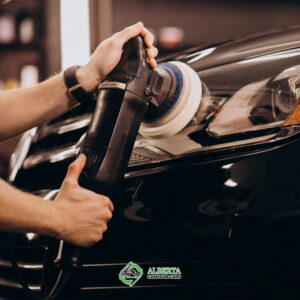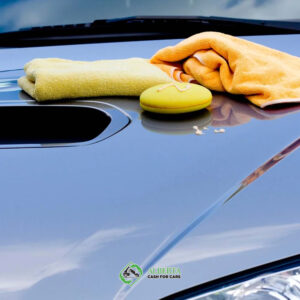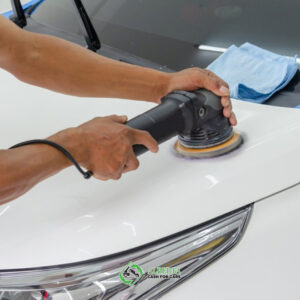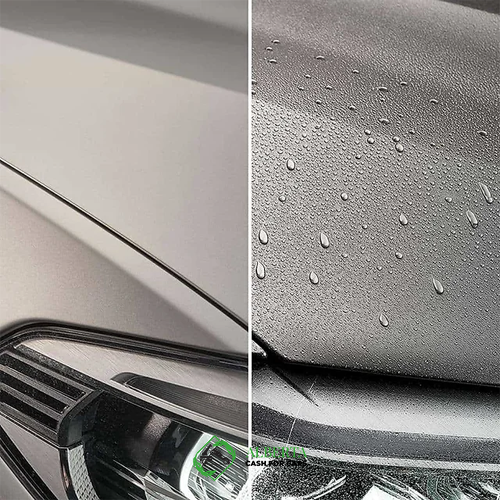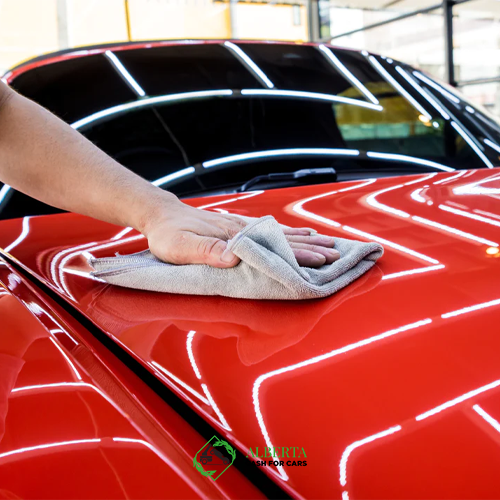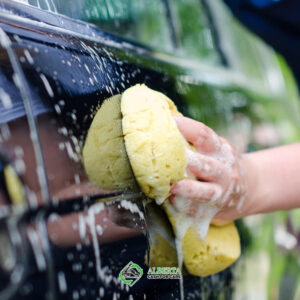Discover the true disparities between car polish and wax, essential for cash for cars calgary enthusiasts seeking to maintain color and lawlessness. Car polish and wax are usually used incorrectly by people who do not have sufficient knowledge of these two substances. When it comes to Car Polish Vs Wax, it is important to know their differences and understand their uses and benefits.
Car polish and wax have the same role for people just looking to keep the car’s color and flawlessness. But the car polish helps achieve that luster, and the car wax helps the polished finish last longer and protects the car’s paint.
No Hassle, Just Cash — Book Your Free Pickup or Quote Today!
What Is Car Polish?
Car polish is a mild abrasive compound designed to clean, smooth, and increase the shine of car paint. Over time, the paint and clear coating on the car, small scratches, signs, and microscopic roughness caused by oxidation on the car. This issue makes the color of the car old and unattractive. People who are car lovers know that everywhere, with the right products and knowledge, the appearance of a car can be restored to a great extent. One of these products is car polish. An electric polisher best does car polishing. This product is designed to be easy to apply. Its process is massaged on the car’s paint, smoothes the defects, and restores the original color.
Different Types of Car Polishers in Calgary
Here are two types of car polishers in Calgary that you can use:
Rotary Polishers
Rotary polishers are powerful tools that utilize a spinning motion to remove defects from the paint surface. They are best suited for experienced users due to their high speed and aggressive nature. While rotary polishers can deliver excellent results, they require careful handling to avoid causing damage to the paint.
Dual Action Polishers
Dual action polishers are a popular choice among car enthusiasts and professionals. They combine both a spinning and oscillating motion, making them safer to use for beginners. Dual action polishers effectively remove imperfections while minimizing the risk of paint damage, making them ideal for most car owners in Calgary.
What Is Car Wax?
Car wax is a product used to protect the car’s exterior. This product helps seal the paint and reduce scratches and other problems caused by the car’s water repellency, dents, and shine. Car waxes are available in different forms, such as paste wax, liquid wax, and spray wax. Due to its thicker consistency, paste wax has more protection than liquid or spray wax for a long time, filling the defects on the car’s surface. Liquid waxes provide long-lasting protection with less effort than paste products; spray waxes are easy to apply but require multiple re-applications. Car waxes are usually made with natural materials from the carnauba palm tree, but more modern formulations also contain synthetic or ceramic materials. Car paint protection with car wax is more of an old method, but many car owners like this method. Benefits of car wax cannot be summarized in a single paragraph, therefore in following sections, we review some of the best benefits of car wax to your vehicle.
Frequency of Waxing
The frequency of waxing depends on several factors, such as climate, driving conditions, and the type of wax used. As a general guideline, it’s recommended to wax your car every three to four months. However, you may need to wax more frequently if your vehicle is exposed to harsh weather conditions or if you notice a decrease in water beading.
Signs That Your Car Needs Waxing
There are a few signs that indicate your car may need waxing. These include water no longer beading on the surface, a loss of shine, and a rough or less smooth feel to the paint. If you notice any of these signs, it’s time to apply a fresh coat of wax.
All types of car wax
There are different types of car wax designed for different levels, payments and purposes. In this section, we introduce several types of car waxes:
- Natural car wax: This type of wax is made from natural materials such as Carnao wax or beeswax and is popular due to its durability and shiny finish.
- Car synthetic wax: This type of wax is made from synthetic materials such as polymers and silicones. This wax is known for its long-lasting protection and waterproof properties.
- Car Wax Spray: This type of car wax is easy to apply and dries quickly. It’s ideal for minor touch-ups between washes, giving you a glossy finish.
- Liquid car wax: This type of car wax is easy to apply and provides a high gloss finish. This wax is ideal for use on large surfaces.
- Paste car wax: This type of car wax provides a lasting finish. It is ideal for use on surfaces with highly oxidized colors to restore their shine.
Common Mistakes to Avoid
When waxing your car, it’s important to avoid certain common mistakes that can affect the results. These include applying too much wax, not buffing off the wax properly, using abrasive materials, and waxing in direct sunlight. Following the proper techniques and using high-quality products will help you achieve the best benfits of car wax.
When to Use Car Polish vs Car Wax
Before you want to answer the question of which Car Polish vs Car Wax is better, it is better to evaluate the condition of your car. First, wash your car thoroughly, then dry it. After that, check the car’s color and touch any rough spots or scratches. If you can see or feel scratches and dents, you should have your car repaired because it is most likely that the stains are below the surface of the car’s paint. If the car’s color is smooth, you can apply some wax according to the product instructions.
In order to increase the brightness of your car’s color and protect it, you should regularly wash, polish, and wax your car. It is recommended to wax your car once every three months to preserve the color of your car. If you carry out the same planning, you can have a scratch-free car. You can indeed get great results using Car Car Polish Vs Wax, but no rule says you have to use both products together. You can use one of them depending on your needs. Be careful not to over polish; this can remove excess paint and ruin the car.
The Science Behind Polishing Compounds
While polishing compound vs wax are both essential for achieving a car’s gleaming finish, polishing compound takes a more scientific approach. Unlike wax, which provides a protective layer, polishing compound works by removing imperfections on a microscopic level.
The Power of Abrasives
Polishing compounds contain microscopic abrasive particles that come in various grades. These abrasives act like tiny sanders, gently buffing away a thin layer of the clear coat. The choice of abrasive grade depends on the severity of the paint imperfections. For example, heavier scratches require a compound with coarser abrasives, while finer abrasives are used for mild blemishes or to refine the finish after using a stronger compound.
Understanding Finishing Grades
Polishing compound vs wax also differs in their final results. After using a polishing compound, even with the finest abrasives, microscopic scratches might remain. This is where finishing grades come in. These are polishes with diminishing abrasives or even no abrasives at all. They further refine the surface, leaving a smooth, glossy finish perfect for applying wax.
Choosing the Right Combination
Selecting the most suitable polishing compound requires evaluating the paint condition. If you’re unsure, it’s always safer to start with a less aggressive compound and gradually move to stronger options if needed. Remember, unlike wax, polishing compound removes a small layer of clear coat. Used excessively, it can damage the paint.
By understanding the abrasives and finishing grades in polishing compounds, you can achieve a level of shine and paint correction far superior to what polishing compound vs wax alone can provide.
Benefits of Car Wax
Car waxing is an important step in car care that offers numerous benefits. By applying a layer of car wax to your vehicle’s exterior, you can enhance its shine, protect the paint, and prolong its overall appearance.
Enhances the Shine
One of the primary benefits of car wax is its ability to enhance the shine of your vehicle. The wax creates a reflective surface that gives your car a glossy and polished appearance. The smoothness of the waxed surface allows light to reflect evenly, resulting in a deep and lustrous shine.
Prevents Oxidation and Fading
Another benefits of car wax is that it can prevents the exterior of your car to fade or oxidate. Exposure to sunlight and UV rays can cause oxidation and fading of your car’s paint over time. Car wax helps protect against these harmful effects by acting as a barrier against UV rays. UV rays can cause fading, discoloration, and deterioration of your car’s paint. This helps maintain the original color and shine of your vehicle’s paint for longer.
Fills in Minor Scratches and Swirl Marks
While car wax cannot fix deep scratches, it can help improve the appearance of minor scratches and swirl marks. The wax fills in the imperfections, creating a smoother surface and minimizing their visibility. This gives your car a more uniform look.
Preserves Resale Value
Regularly waxing your car can help preserve its resale value. The protective layer provided by car wax helps prevent paint damage and keeps the exterior looking well-maintained. A car with a well-preserved paint finish is likely to attract more potential buyers and fetch a higher price.
New Advanced Ceramic Coatings as an Alternative
Calgary car polishing has witnessed a game-changing innovation with the rise of ceramic coatings, offering a modern twist to the conventional waxing method. These advanced formulations incorporate elements like silicon dioxide, titanium dioxide, or silica, forming a resilient bond with your car’s paint that promises a lustrous shield lasting for years. While ceramic coatings do come at a slightly higher price point, the payoff is a dazzling hydrophobic gleam akin to glass, effortlessly repelling water droplets. For the best outcomes, it’s advisable to opt for professional installation. Interestingly, certain ceramic spray products have also surfaced, allowing car enthusiasts to indulge in a DIY application for added convenience. It’s an exciting shift that showcases innovation at its finest in the world of car care.
Key Differences between Car Polish and Wax
While both car polish and wax contribute to the overall appearance and protection of your vehicle, there are key differences between them:
Primary function
Car polish is primarily used to restore the shine and remove imperfections from the paint, while car wax is focused on providing a protective layer to shield the paint from external elements.
Application method
Car polish is typically applied using a machine polisher or by hand with a microfiber cloth, allowing the abrasives to work effectively on the paint surface. On the other hand, car wax is applied by hand or with a foam applicator pad, forming a thin protective layer on top of the paint.
Protection and durability
Car polish does not offer long-lasting protection and requires frequent application, while car wax provides a more durable protective layer that can last for several months, depending on the type of wax and environmental conditions.
Effect on the car’s appearance
Car polish enhances the visual appeal by removing imperfections and restoring the shine, while car wax adds depth, gloss, and a smooth finish to the paint, giving it a sleek and polished look.
Choosing the Right Car Polisher
Selecting the appropriate car polisher in Calgary is crucial to achieve the desired results and ensure a smooth polishing process. Here are some factors to consider when choosing a car polisher:
Power and Speed Settings
Opt for a polisher with adjustable power and speed settings. This feature allows you to customize the tool’s performance based on the specific requirements of your vehicle’s paint and the level of imperfections you need to address.
Ergonomics and Handling
Consider the ergonomics and handling of the polisher. Look for models with comfortable grips, lightweight designs, and good balance to minimize user fatigue during prolonged use.
Backing Plate Size
The size of the backing plate on the polisher determines the coverage area and affects the overall efficiency of the polishing process. Choose a backing plate size that matches the size of your car for optimal results.
Choosing the Right Protection for Your Vehicle
When deciding between car polish and wax, consider the following factors:
Assessing your car’s needs
Evaluate the condition of your vehicle’s paint and determine whether it requires correction or simply needs protection. If the paint has scratches or swirl marks, using a car polish followed by waxing can be a suitable option. For well-maintained paint, regular waxing may suffice.
Frequency of application
Car polish is typically used when necessary, such as when the paintwork has imperfections. Waxing, on the other hand, should be done regularly to maintain the protective layer on the paint. Consider your time and maintenance preferences when deciding on the frequency of application.
Professional detailing services
If you’re unsure about the best approach for your car or prefer professional assistance, consider seeking the services of a reputable auto detailing professional. They have the expertise and knowledge to assess your car’s needs and provide the appropriate treatments for optimal results.
Related Post:
Easy DIY Car Repairs that You Can Do Yourself
Common Polishing and Waxing Mistakes to Avoid
Applying an excess of wax or engaging in enthusiastic car polishing in Calgary can unexpectedly result in a cloudy residue that demands extra buffing effort. It’s a common misstep to let wax or polish sit until fully dried, making the removal process quite a challenge. Opting for subpar absorbent towels may leave behind unwanted lint and pesky scratches. Sun-soaked Calgary car polishing or waxing sessions can lead to sticky situations. Failing to adequately prep your vehicle can lead to unwelcome polishing grit and dirt becoming embedded in your paint. Over-enthusiastic polishing without a gentle touch can potentially lead to thin clear coats being compromised.
How should I apply polish and wax?
If you are looking to know how to Car Polish Vs Wax your car, you can see the steps below:
- First, wash your car with water and shampoo. Be sure to dry the car completely with a soft dry cloth so that no water spots remain on it. Try to do this where there is no sun. If you wash the car under the sun or when the weather is hot, you will cause water spots to form on your car after drying. As a result, it will not look very interesting after polishing.
- After washing the car, it is time to polish. Apply the polish on a suitable pad and apply the product to your car according to the instructions. Try to do this in a circular motion. You can do this by hand or with special devices. Using special devices requires less time and effort.
- Polish the car’s surface until the polishing compound is gone and only the shiny color remains. Then you can continue polishing the next area. Remember to stop the process when the polish is gone because you may dull the car’s surface if you continue.
- After this, waxing the car to protect the coating and make it shine a little more is better. Of course, before doing this, you should wash and drain the car to remove any remaining polish.
- After washing and drying the car again, you can start waxing. Pour some wax on a pad or sponge and apply it on the car’s surface in circular motions. Unlike polish, you must allow the wax to dry before smoothing. After drying, clean the area with a clean microfiber towel. Now your car has got a great shine.
Proper Wash and Prep Steps Before Polishing or Waxing
Thorough washing and decontamination ensure optimal polish and wax results. Hand wash with high-lubricity soap to avoid swirling. To rid your car’s surface of any lingering contaminants, a clay bar treatment works wonders by tackling bonded brake dust. For those stubborn deposits like tar or bugs, dedicated removers or scrubbers come to the rescue. And let’s not forget iron removers, which excel at extracting metallic particles that might be hanging around. When you’re aiming to create the ideal canvas for your polish and wax, don’t skip the step of using a compound cleaner to eliminate old wax or sealant layers. Proper preparation, after all, ensures a clean slate for a stunning finish.
Types of Compounds
1. Abrasive Compounds
Abrasive compounds are the frontline warriors against deep-seated imperfections in your car’s paintwork. These compounds come in varying grit levels, allowing for tailored solutions to different degrees of defects. Seasoned detailers often prefer abrasive compounds for their effectiveness in intensive paint correction.
2. All-in-One Compounds
All-in-one compounds are a versatile solution, blending cutting and polishing agents. This type of compound is ideal for automotive enthusiasts seeking efficiency without compromising on the quality of results. It streamlines the detailing process, making it accessible for those who want a comprehensive solution without delving into the intricacies of multi-step corrections.
Application Techniques
Mastering the art of applying a compound is pivotal to its effectiveness. Whether you choose the hands-on approach or let a machine take charge, understanding the proper techniques ensures optimal results. The application technique influences the level of correction, depth of shine, and overall finish. Detailers often use dual-action or rotary polishers to maximize the efficacy of the compound.
When applying by hand, circular or cross-hatch motions evenly distribute the compound, preventing uneven correction. It’s crucial to work in small sections, ensuring that the compound doesn’t dry before removal. For machine application, speed settings and pressure play key roles. Adjusting these factors allows for controlled correction without compromising the paint in compound vs polish vs wax field.
Considerations
While compounds are potent tools in the hands of skilled detailers, they come with inherent risks. Misuse or over-application can lead to paint damage, especially on thin or sensitive clear coats. It’s essential to be mindful of the environmental impact, ensuring proper disposal practices. Many modern compounds are formulated to be eco-friendly, aligning with the growing demand for sustainable detailing solutions.
Brands and Reviews for Compound vs Polish vs Wax
When it comes to compound vs polish vs wax, navigating the myriad of compound brands can be daunting, but user reviews and recommendations serve as valuable guides. Renowned brands such as Meguiar’s, 3M, and Griot’s Garage have established themselves in the detailing industry, with users often providing insights into real-world applications. Before making a choice, consider the specific needs of your vehicle and the severity of defects you aim to address.
Emerging Trends in Compound Technology
As automotive detailing evolves, compounds continue to witness advancements. Nanotechnology-infused compounds, for instance, boast finer abrasive particles, allowing for smoother corrections with reduced risk of micro-marring. Water-based and low-VOC (Volatile Organic Compound) formulations are gaining popularity, addressing environmental concerns without compromising on performance.
In the ever-changing landscape of automotive detailing, staying informed about emerging trends ensures that your choice of compound aligns with the latest innovations in the industry.
Safe Washing Techniques to Avoid Paint Swirling
Careless washing creates tiny circular scratches or swirl marks in the paint’s clear coat. Use the two bucket wash method – one for soap and one just for rinsing. Remember to rinse your mitts often, using gentle strokes and minimal pressure. Opt for the gentleness of microfiber mitts instead of terry towels. Select high-lubricity soaps and ensure the paint remains wet as you wipe it down. To steer clear of circular motions that could lead to scratches, be mindful of your technique. Finally, finish strong by giving your car a thorough rinse and a careful drying session.
The Benefits of Hiring Professional Car Polishing Services
While self car polishing can be rewarding, hiring professional car polishing services in Calgary offers several advantages:
Expertise and Experience
Professional detailers have extensive knowledge and experience in car polishing. They possess the skills to address a wide range of paint imperfections and can provide tailored solutions for your vehicle.
Time and Convenience
Car polishing can be a time-consuming process, especially for beginners. By outsourcing the task to professionals, you can save time and focus on other important aspects of your life.
High-Quality Results
Professional car polishers in Calgary utilize advanced techniques and tools to deliver exceptional results. They have access to high-quality products and are well-versed in the latest polishing methodologies, ensuring a superior finish for your vehicle.
Should I do anything before applying polish or waxing?
Our usual suggestion is to wash your car thoroughly by hand and remove as much debris and surface contamination as possible. We do not recommend commercial car washes because, over time, signs of rotation, scratches, and stains may appear on the car.
Car Polish Vs Wax help indeed remove debris and dirt from the car’s surface, but if your car is already clean, polishing will be much easier and faster. If you choose to wax your car without polishing, you must go through the steps of cleaning or washing the car before doing the work.
Benefits Of Car Polish vs Wax
Here are some of the different benefits of using Car Polish vs Wax:
- These products form a protective layer on the car’s paint, which helps prevent damage caused by ultraviolet rays, bird droppings, and environmental pollutants.
- These products help to increase the color’s brightness and give the car a shiny appearance.
- They help improve water resistance and prevent rust and damage.
- They make cleaning the car easier because less dirt and debris stick to the polished surface.
- They provide long-lasting protection to your car’s paint and keep it looking its best for months.
- They remove small scratches and swirl marks from the paint surface and give the car a smooth and even finish.
Understanding the purpose of car wax vs polish
car wax vs polish are two of the most essential products to maintain the beauty of your car’s appearance. You may think that both are similar, but it is better to know that their goals are different.
The purpose of car wax is to protect the color of the car. This material creates a hydrophobic effect, repels water and prevents the formation of water spots. It also provides a glossy finish that improves the look of the car and makes it look newer and more attractive.
On the other hand, car polishing restores the original color and shine of your car and makes it look brighter. It can be used before using car wax to remove any defects from the surface of the paint and make sure it is shiny and smooth.
When used together, these two can help preserve the appearance of your car for years to come. It is important to note that excessive use of car wax and polish can damage the color of your car, so you must follow the manufacturer’s instructions carefully and use them sufficiently.


